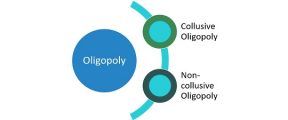 In a market, you can find different forms of imperfect competition for different products and services. Monopoly and oligopoly are two of them, wherein monopoly can be seen for those products that do not have competition, while oligopoly can be observed for items with stiff competition.
In a market, you can find different forms of imperfect competition for different products and services. Monopoly and oligopoly are two of them, wherein monopoly can be seen for those products that do not have competition, while oligopoly can be observed for items with stiff competition.
Monopoly is a market condition whereby only one seller is selling an entirely heterogeneous product at the marketplace, having no close substitutes to the product offered by the seller. On the other hand, oligopoly is a type of competition whereby there are a few number of vendors in the market selling differential products or nearly differential products. In an oligopoly, there are only few firms operating in the market and so, the sellers are influenced by the activities of other sellers.
In the article presented to you, we are going to talk about the differences between monopoly and oligopoly, take a read.
Content: Monopoly Vs Oligopoly
Comparison Chart
| Basis for Comparison | Monopoly | Oligopoly |
|---|---|---|
| Meaning | Monopoly is a form of market structure, where only one seller sells his distinctive product and dominates the entire market. | A market situation in which there are few firms in the market that sells either homogeneous or differentiated product and compete in the market. |
| Number of players | One | Two to ten |
| Product Differentiation | Extreme | None to substantial |
| Competition | Does not exist. | Little |
| Prices | High prices are charged. | Fair prices are charged. |
| Control over price | Very considerable | Some |
| Basis of setting price | Demand of consumers for the product. | Competitors prices. |
| Restrictions to entry | Due to economic, institutional, legal or any other reason. | Due to economies of scale. |
Definition of Monopoly
In simple terms, Monopoly means ‘sole to sell.’ It is a situation of the market where there exists only one seller in the market for a particular commodity or service, supplying goods to many customers and he has ultimate control over it. The product or service offered by the seller is unique, and do not have any close substitutes. Due to the dominance of the whole market, they enjoy the benefit of large scale production. The salient features of monopoly are as follows:
- There is only one seller in the whole market who produces or supplies a product.
- Entry to such a market is restricted due to factors like license, ownership of resources, etc.
- There are no close substitutes of the commodity offered by the monopolist.
In a monopoly market, there is no competition and so the monopolist overcharges the prices of products. Under this market structure, price discrimination exists in a way that the price varies from customer to customers for the same product.
The prices also differentiate according to the quantity demanded by the buyer i.e. if the quantity demanded is high; then the low price is charged and vice versa. This practice is followed to reap maximum revenue, to dispose of the excess stock or to capture foreign markets.
Definition of Oligopoly
In simple terms, oligopoly refers to ‘competition among the few‘. It is an economic situation where there is a small number of firms, selling competing products in the market. The oligopoly exists in the market, where there are 2 to 10 sellers selling identical, or slightly different products in the market. According to experts, an oligopoly is defined as a situation when the firm sets its market policy, as per the anticipated behaviour of its competitors.
In an oligopolistic market, a firm has to rely on other firms for taking decisions regarding prices because the slightest change in the price of rivals may cause loss to the firm.
The other feature of this type of market is the use of marketing tools like advertising to get the maximum market share. Each and every firm of the industry, closely observe the moves and actions of the competitors to plan its steps according to the behavior of its rivals.
The following are the various forms of oligopoly:
- Collusive oligopoly is when the firm act, in cooperation with other firms in the market in setting the price and output.
- Competitive oligopoly is when cooperation is missing between firms, and they compete with one another.
- Perfect oligopoly is when the product is identical in nature.
- Imperfect oligopoly is when firms sell different products.
- Open oligopoly is when the new firms are free to enter.
- Closed oligopoly is when restrictions are there for entering the market.
- Others include partial or full oligopoly, syndicated or organized oligopoly, etc.
Key Differences Between Monopoly and Oligopoly
The following are the major differences between monopoly and oligopoly:
- Monopoly refers to a type of market, having a single seller dominating the whole market. The economic structure where there are a handful of sellers in the market selling similar products and competing among themselves.
- In monopoly, as there is a sole seller of a product or provider of service, the competition does not exist at all. On the other hand, in oligopoly, a slight competition is there among the firms.
- In a monopoly, there is only one player in the entire market, but in oligopoly, the range of players is 2 – 10, in the market.
- In a monopoly, the seller dominates the market by selling a unique product for which no substitute is available. Conversely, in an oligopoly, the products or service offered by the firm are either similar or different having close substitutes.
- In a monopoly the price discrimination exist; different customers have to pay a different price for the same product. In contrast to oligopoly, price remains fixed for a long time.
- In an oligopoly, the firms set the product price on the basis of the price of the same product offered by the rival seller in the market, which is just opposite in the case of monopoly, as there are no rivals.
- The reasons for restriction on entry into the monopoly market can be legal, economic or institutional, but the major barrier in oligopoly is economies of scale.
Example
Monopoly
Practically, the monopoly can be seen in services related to the public utility like transport, electricity, water and so on.
Oligopoly
One can find oligopoly in industries like a cold drink, automobiles, telecommunication etc.
Conclusion
In practical life, we find monopolies in transport like railways and other public utility services only, but oligopoly exists in many industries of the economy like the automobile industry, telecommunication industry, soft drink industry, plastic industry, etc.






Muqadas says
Awsome thank u soo much 😍😍😍😍
Anmol says
Amazing’👌this is very helpful 🙏
farid lotfi says
fascinating…GOD bless you…very very practical for me!
Jeffrey says
Thank you very much
You have helped me a lot 😍😍
Stecy says
Thank alot❤️